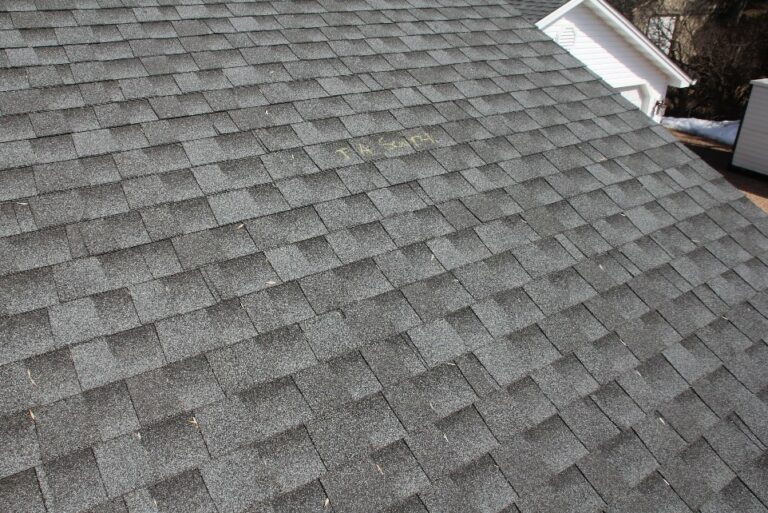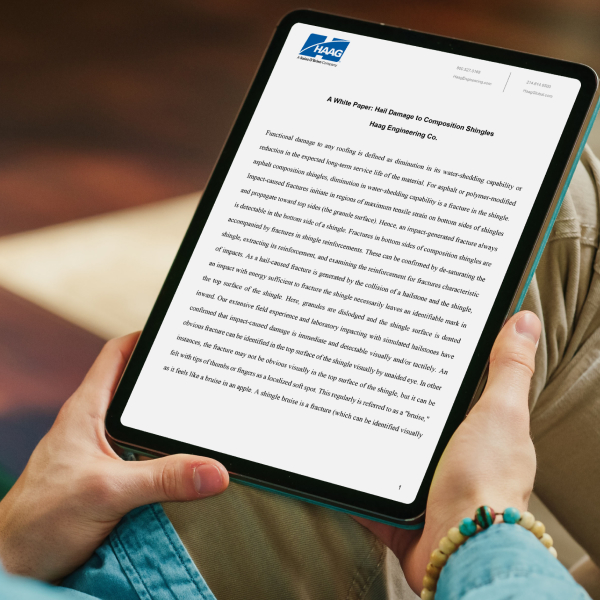Haag’s Test Square Method
As we commemorate Haag’s 100th anniversary, we reflect on a century of remarkable and pivotal projects that have defined the legacy of Haag.
One such enduring contribution is Haag’s Test Square Method, a methodology pioneered by Haag engineers since the early 1960s. This method stands as a testament to simplicity, precision, and repeatability in assessing the extent of hail damage on roofs. Its significance lies in the establishment of clear rules and procedures for hail damage assessment, helping to eliminate disagreements among professionals in the field.
The Test Square method has evolved into the standard inspection procedure for determining hail damage worldwide, used by contractors, adjusters, engineers, and various stakeholders, attesting to its universal applicability.
The genesis of this methodology dates back to the 1960s, when assessing hail damage on cedar shingle roofing was a common challenge. With cedar shingle roofs boasting 350-400 individual shingles per square (100 square feet), a comprehensive assessment was a time-consuming task. In response, visionaries such as Wayne Parish, John Stewart, Stoney Kirkpatrick, and others at Haag Engineering deliberated on employing statistical sampling for hail damage assessment.
After experimenting with different sample area sizes, they found that 100 square feet or one roofing square struck the perfect balance—being statistically representative, practical in terms of time, and easily comprehensible in discussions. Recognizing the directional impact of wind-driven hail, a decision was made to conduct a test square on each directional face of the roof.
The methodology made its formal debut in “Hail Damage to Red Cedar Shingles” (American Insurance Association, 1975) and later in Haag’s publication “Hail Damage to Wood Shingle and Shake Roofs: Assessment Criteria” (Haag Engineering Co., 1985). Subsequently, it underwent peer review and was presented as a comprehensive procedure two decades ago at the North American Conference on Roofing Technology in a paper titled “Protocol for Assessment of Hail-Damaged Roofing” (Tim Marshall and Richard Herzog, 1999). Today, the Haag Test Square Method endures as a cornerstone in the realm of hail damage assessment, embodying a legacy that spans decades and continents.

While initially developed for cedar shingle roofs, the Haag Test Square Method has proven its adaptability to a variety of steep slope roofing systems, including cedar shakes, concrete and clay tiles, as well as asphalt shingles.
Additionally, its applicability extends to assessing hail-caused damage on low slope membrane roof systems.
The method is simple:
- Draw out a 10×10 ft. square on each directional roofing slope, avoiding overhanging trees and areas of concentrated foot traffic if possible.
- Examine every shingle, shake, or tile within that square closely, including hand-manipulating to check for creases, breaks, soft spots, and bruising.
- Record and differentiate the types of marks or physical damage found within that test square. For assessment of hail damage, determine a count of how many roofing units have been hail-damaged in the test square. (For low-slope membrane roofing, the count represents how many hail-caused fractures, punctures, or ruptured areas exist in the test square.)
- Calculate the actual roofing area (in squares) that face each direction.
- The test square results can then be extrapolated for the entire roof by multiplying the numbered of damaged shingles per square by the roofing squares for each direction, producing an estimate of damaged shingles for the entire roof.
Repair Cost Estimation:
- Determine the repair cost estimate for the hail-caused damage using a unit repair costs applicable for the roofing material and geographical area through the DURA formula as shown below.
- Repair Cost = D x U x R x A
- D: Number of damaged shingles, shakes, or tiles per roofing square
- U: Unit cost to repair a shingle, shake, or tile
- R: Repair Difficulty Factor (1, 1.5, or 2)
- A: Actual area of the slope (in roofing squares)
As a comprehensive and adaptable approach, it continues to stand as a cornerstone in the field of hail damage assessment.
References– 1975 Red Book (AIA), 1985 Haag Assessment Criteria, and the 1999 Protocol Paper.
Author

RICHARD HERZOG, FORENSIC ENGINEER
Richard Herzog is a Principal Engineer, Meteorologist, and Minneapolis Office Engineering Manager at Haag Engineering Co. He has been with Haag for over 28 years, and is a licensed Professional Engineer in 14 states. Mr. Herzog is an active member of the National Roofing Contractors Association, the Roof Consultants Institute, the Roofing Industry Council on Weather Issues (RICOWI), Minnesota Society of Professional Engineers, and the Cedar Shake and Shingle Bureau. He earned Bachelors of Sciences degrees in Civil Engineering and Meteorology from Penn State University.
Mr. Herzog’s primary areas of consulting are Roofing Systems, Building Envelope Systems, Evaluation of Wind Damage to Structures, Construction Defect Evaluations, Meteorological Investigations, Development of Hail Analysis Software, and Alternative Dispute Resolution. He serves as a primary advisor in the creation of many Haag Education seminars and products.
*Richard’s original blog was posted in April 2019.
Any opinions expressed herein are those of the author(s) and do not necessarily reflect those of Haag Technical Services, Haag Engineering Co., Haag Education, or parent company, Haag Global, Inc.

